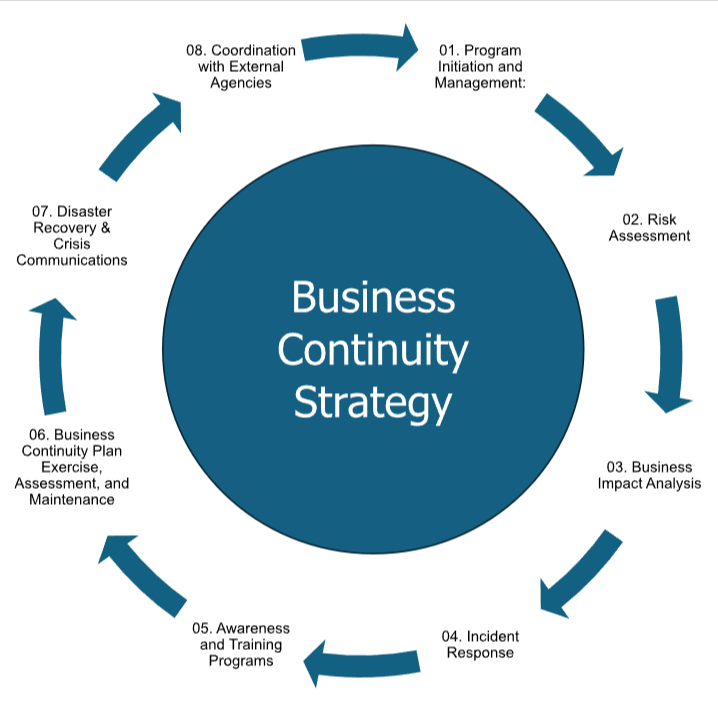Introduction
In the fast-paced and unpredictable world of business, uncertainty is a constant companion. To not only survive but thrive in the face of disruptions, organizations have strong reasons to embrace Business Continuity Management (BCM) as a strategic imperative. This post delves into the essence and key components of BCM, its various stages and best practices. It aims to offer some profound insights into BCM’s pivotal role in safeguarding business operations and ensuring resilience. Business leaders can leverage technology to manage BCM and build business resilience.
What is Business Continuity Management?
Business continuity management is like a big puzzle, not easy to grasp all at once. It is understandable, though, since its goal is to quickly rebuild a company’s foundation when things go wrong.
BCM is not a mere concept—it is the lifeblood that sustains an organization in times of turmoil. A swift and decisive response orchestrated through the principles of BCM can mean the difference between a company’s revival or ruin in the face of adversity. Business Continuity Management (BCM) encompasses a set of processes and procedures designed to ensure that essential functions within an organization can continue during and after a disaster or disruption. It involves identifying potential risks, developing strategies to mitigate these risks, and establishing protocols to maintain critical operations in the face of adversity.
The primary goal of a BCM is to strengthen an organization’s defense against potential disruptions and maintain critical business functions during unforeseen crises.
Key Differences Between Business Resilience, Continuity, And Recovery
Let us start by clearing up some confusion about what resilience means. Traditionally, companies would have disaster management and crisis management strategies in place, but modern businesses understand that many existential threats are more subtle than earthquakes or stock market crashes.
For this reason, your strategies need to be just as explained in short. Here is what each term means.
Business Resilience
Resilience describes how prepared a business is to confront difficult circumstances. Continuity planning and disaster recovery are part of overall resilience.
Business resilience standards are characterised by factors such as:
- How securely it can deliver profits to shareholders.
- How well-protected its assets are from attacks or disasters (both physical and digital)
- Whether it has established communication channels for emergencies
- Whether its workers have continuity measures in place to maintain productivity in trying times (e.g. working from home or having access to necessary software)
- Whether it has identified alternative growth opportunities if its main offering becomes obsolete or demand drops
Business Continuity
Business continuity management serves as a strategic framework for businesses to persist and uncover new avenues amidst adversity. Unlike disaster recovery, it encompasses responses to both gradual deteriorations and sudden, unforeseen incidents.
Disaster Recovery
The cornerstone of resilience lies in disaster management and recovery planning. Given the diverse nature of disasters, resilient companies anticipate most eventualities by simulating worst-case scenarios and making necessary arrangements.
Disaster recovery plans anticipate responses to various unexpected challenges, including:
- Natural disasters (e.g., earthquakes, hurricanes, tsunamis)
- Cyberattacks disrupting operational systems.
- Severe economic downturns
- Imposed social restrictions (e.g., the COVID-19 pandemic)
- Supply chain disruptions due to global events like wars or natural disasters along the supply chain.
Developing strategies for disaster recovery and overarching continuity enhances a business’s resilience. The ability to withstand and thrive in the face of disruptions marks the true measure of resilience.
Key Takeaway
Business Resilience reflects the business’s ability to adapt, recover, and thrive amidst challenges encompassing continuity planning, disaster recovery, asset protection, effective communication, and readiness for alternative growth opportunities.
How securely it can deliver profits to shareholders is one of the primary goals.
Business Continuity is the ‘Corporate guardian’ it is responsible for maintaining essential functions during and after a disruption. It involves planning processing and systems to prevent and recover from potential threats, ensuring minimal impact on operations and service delivery.
The main goal of Business Continuity Management is to ensure uninterrupted operation during disruptions.
Disaster Recovery involves procedures and strategies to restore infrastructures and operations after a catastrophic event, ensuring minimal downtime and data loss.
RTO, RPO, and RCO define key metrics for a disaster recovery plan. RTO specifies maximum acceptable downtime, RPO determines allowable data loss, and RCO ensures data consistency and recovery.
The main goal of a Disaster Recovery Plan is to minimize downtime and restore operations swiftly.
What is a Business Continuity Program?
A Business Continuity Program is a comprehensive framework comprising strategies, policies, and procedures designed to ensure an organization’s resilience against disruptions and its ability to continue essential operations. It encompasses business continuity planning, disaster recovery, risk management, and crisis management. Let us have a look at what experts suggest BCM Managers and industry leaders to embrace when they embark on BC Program.
The Professional Practices for Business Continuity Program

BCP Objectives
Program Initiation and Management
Establish the need for a business continuity program.
Obtain support and funding for the business continuity program.
Build the organizational framework to support the business continuity program.
Introduce key concepts, such as program management, risk awareness, identification of critical functions/processes, recovery strategies, training and awareness, and exercising/testing.
Risk Assessment
Identify risks that can adversely affect an entity’s resources or image.
Assess risks to determine the potential impacts to the entity, enabling the entity to determine the most effective use of resources to reduce these potential impacts.
Business Impact Analysis
Identify and prioritize the entity’s functions and processes to ascertain which ones will have the greatest impact should they not be available.
Assess the resources required to support the business impact analysis process.
Business Impact Analysis (BIA) is a brief but intense activity, it sets out clearly the rate of financial, reputation and human loss following any major incident. It tells us how much risk we face and how fast we must restore each operational component to ensure continuity.
Incident Response
Develop and assist with the implementation of an incident management system that defines organizational roles, lines of authority and succession of authority.
Define requirements to develop and implement the entity’s incident response plan.
Ensure that incident response is coordinated with outside organizations in a timely and effective manner when appropriate.
Awareness and Training Programs
Document plans to be used during an incident that will enable the entity to continue to function. Ensure periodic drill planning, internal communication, and training certification for all employees.
Business Continuity Plan Exercise, Assessment, and Maintenance
Establish an exercise, assessment, and maintenance program to maintain a state of readiness. Ensure developing key metrices like RTO, RPO, RCO for critical process, document SPOF & develop an approved robust plan
Crisis Communications
Provide a framework for developing a crisis communications plan.
Ensure that the crisis communications plan will provide for timely, effective communication with internal and external parties.
Coordination with External Agencies
Establish policies and procedures to coordinate incident response activities with public entities
Finding the big weaknesses in a company’s defence is tough. It needs careful planning, checking risks, and making sure security measures are strong. Fixing these big problems means being proactive, BC Managers make sure the company can handle any threats. It’s all about staying alert and planning ahead to keep the company safe. BC Managers should identify and plug the big holes first and then for each hole, identify and apply the best value solutions.
Leverage Technology to achieve Business Resilience
Leveraging technology is crucial for ensuring an organization’s resilience and ability to thrive even during challenging times. Here are the advantages and reasons why you should embrace technology for implementing effective BCM:
- Strengthening Business Continuity:
As technology evolves, its capacity to enhance business continuity planning grows exponentially.Advantages:
- Improved Information Flow: Technology facilitates seamless communication and data sharing across the organization, ensuring critical information reaches the right people promptly.
- Enhanced Data Security: Robust cybersecurity measures safeguard sensitive data, preventing breaches and disruptions.
- Remote Work Capabilities: Technology enables remote work, allowing employees to continue operations even during crises.
- Critical Insights and Analysis: Digital tools provide real-time data and analytics, helping leaders make informed decisions about company health.
- IT Department’s Role:
IT department ensures technology infrastructure resilience, data protection, and continuity, crucial for business operations during disruptions.Responsibilities:
- Data Safety: IT ensures data remains secure, whether on-premises or in the cloud.
- System Continuity: Keeping digital systems operational, including servers, applications, and workstations.
- Disaster Recovery: Implementing strategies to recover from unexpected events.
- Adaptation to New Challenges: Organizations rely on IT to handle emerging technologies and address evolving threats.
- Choosing the Right Technology:
The correct technology depends on your organization’s unique needs and context.As best practise organization should consider the following factors:
- Scalability: Ensure the technology can grow with your organization.
- Integration: Choose solutions that seamlessly integrate with existing systems.
- Security: Prioritize robust security features.
- Cloud Services: Evaluate cloud-based options for flexibility and accessibility.
- Collaboration Tools: Enable efficient communication and collaboration among teams.
- Automation: Use technology to automate routine tasks and processes.
- Monitoring and Analytics: Implement tools for real-time monitoring and data-driven insights.
- Vendor Support: Assess the reliability and support provided by technology vendors.
Conclusion
In summary, leveraging technology in Business Continuity Management (BCM) offers numerous advantages, including enhanced efficiency, real-time monitoring, automated alerts, and streamlined communication during crises. Using technology is crucial to ensure swift responses to disruptions, improve resilience, and minimize downtime. The correct technology for BCM should encompass crisis management tools, IT disaster recovery solutions, communication platforms, and automated systems for risk assessment and response planning.
Organizations can benefit from SAI360 BCM solutions to drive resilience, efficiency, and strategic agility in their BCM efforts. Check out more here.






